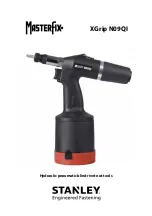
Model T28325 (Mfd. Since 1/18)
-17-
2. Rotate one setback adjustment knob a small
amount, then rotate other knob same amount
and direction. This prevents bending leaf
from binding on setback shafts and keeps it
parallel with clamping leaf.
3. Repeat Step 2 until you have correct set-
back, then re-tighten hex bolts.
Tip: Use calipers to precisely check the set-
back.
Item(s) Needed
Qty
Open-End Wrench or Socket 14mm ................. 1
Calipers (Optional) ............................................. 1
To adjust setback:
1. Loosen hex bolts (see Figure 14) on each
side of bending leaf.
Figure 14. Setback controls.
Setback
Adjustment
Knob
Graduated
Dial
Hex Bolt
(1 of 2)
Adjusting Setback
Setback is the required distance between the
bending blocks and the clamping fingers to prop-
erly make the bend (see
Figure 13). A number of
factors determine the correct setback distance,
such as bend allowance, bend radius, and mate-
rial thickness.
There are many sources to help you calculate the
correct setback for your operation, such as metal-
working handbooks, the internet, or experienced
sheet metal workers.
Bending
Block
Clamping
Base
Setback
Clamping
Finger
Figure 13. Identification of setback.
Adjusting Clamping
Pressure
When securing the workpiece with the foot pedal,
the correct clamping pressure depends on the
workpiece thickness. The ideal pressure locks the
workpiece firmly in position between the clamping
fingers and base without excessive compression
that could damage the workpiece or brake.
Rotate one pressure adjustment knob (see
Figure 15) a small amount, then rotate the other
knob the same amount and direction. This pre-
vents the clamping leaf from binding on the shafts
and keeps it parallel with the clamping base.
Figure 15. Pressure adjustment knob.
Pressure
Adjustment
Knob
Graduated
Scale
Collar
Summary of Contents for T28325
Page 32: ......














































